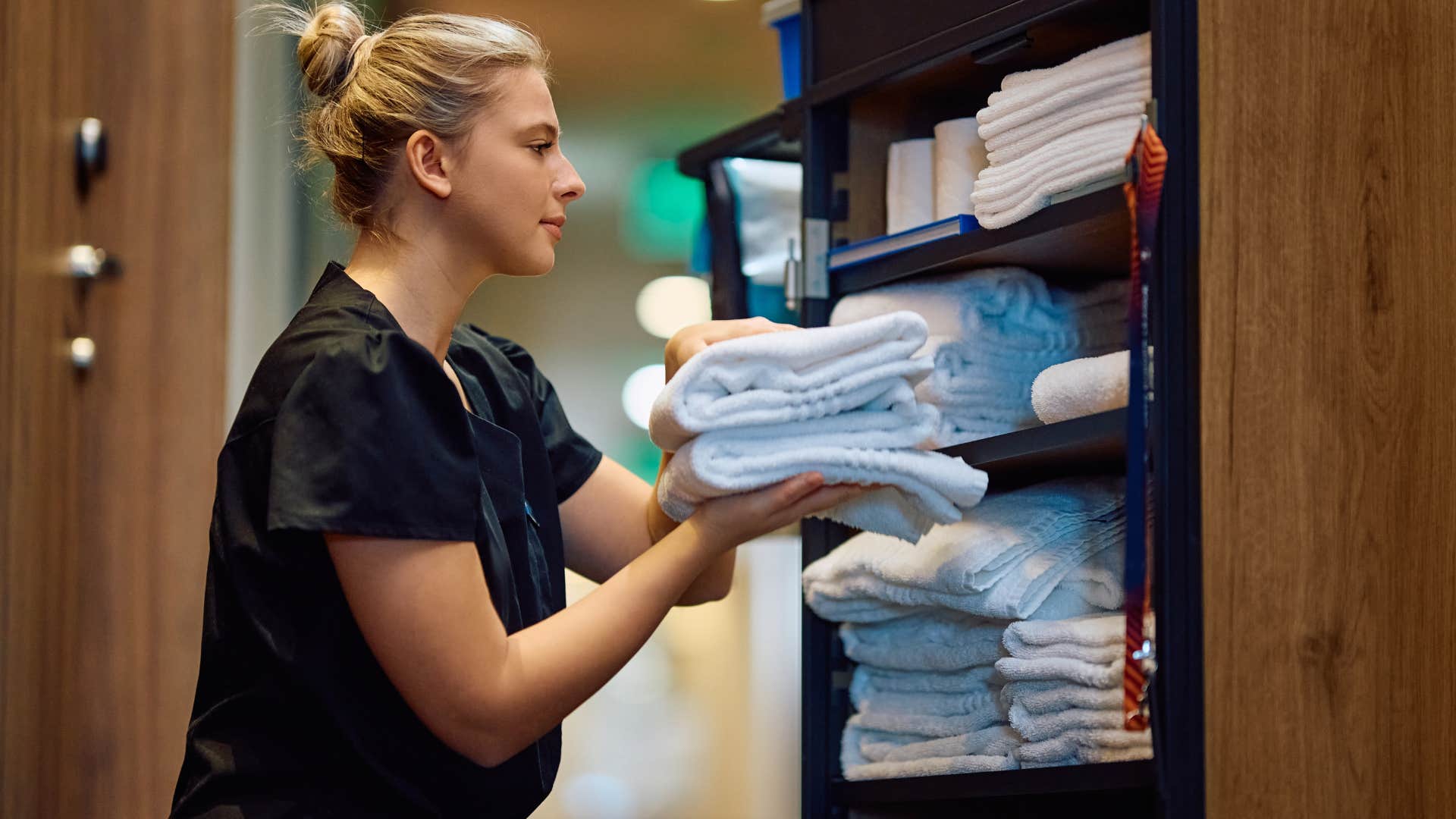11 Signs You’re Actually Upper Middle Class Even If You Feel Like You’re Struggling All The Time
You know it's bad when living paycheck to paycheck becomes the new status symbol.
 ImYanis / Shutterstock
ImYanis / Shutterstock Nearly a quarter of middle-income individuals struggle to pay all of their bills every month, according to a study from the Pew Research Center, causing them to make compromises, prioritize high-interest bills, and shoulder late fees until their next paycheck. So, technically, even if you’re living paycheck to paycheck, you’re doing better than many middle-class Americans, because you’re technically paying all your required bills, even if it’s a stretch and takes some sacrifice.
Considering how debilitating and disorienting financial stress can be, it’s not surprising that many people feel like they’re doing worse than everyone else, even when they’re not. In fact, some of the signs you’re actually upper-middle class, even if you feel like you’re struggling all the time, will probably sound pretty sad. And while it may not necessarily be comforting to know that others are suffering more than you, it can put the picture of gratitude into perspective.
Here are 11 signs you’re actually upper-middle class even if you feel like you’re struggling all the time
1. You can afford childcare
 Lordn | Shutterstock.com
Lordn | Shutterstock.com
According to a report from the Center for American Progress, many families are spending over $1K monthly on childcare, with some dedicating between 50 and 70% of their housing budget to things like daycare or a babysitter. Many middle-class families have even been pushed into poverty over struggles with affordable and accessible childcare, needing to quit a job or stay home with their kids to make ends meet.
So, if you can still afford childcare while working, that’s one of the signs you’re actually upper-middle-class, even if you feel like you’re struggling all the time. It may not be easy all the time to afford your monthly bills, but you’re not struggling under money stress or considering resigning from a job like many middle-income families.
2. You can afford groceries every month
 Prostock-studio | Shutterstock.com
Prostock-studio | Shutterstock.com
Nearly 39 million Americans experienced food insecurity in 2020, according to data from the U.S. Department of Agriculture, and that number has only continued to rise in recent years alongside economic turmoil. Despite what you might believe, it’s not only low-income people living in poverty who struggle to afford food and put meals on the table, but also your middle-income neighbors and friends.
If you can afford to buy groceries once or twice a month, making meals at home for your family without cutting back, waiting for deals, or relying solely on cheap, canned, and generic alternatives, you may actually be upper-middle-class, even if you feel like you’re struggling all the time.
3. You have enough money to pay all of your bills
 PeopleImages | Shutterstock.com
PeopleImages | Shutterstock.com
If you’re living paycheck to paycheck, chances are you feel behind compared to everyone else, but according to a MarketWatch study, nearly 60% of Americans are currently in this financial situation. In our economic climate, consider yourself lucky if you’re able to afford all your bills without pushing some to the next paycheck or using credit cards to fund basic necessities.
Especially if you have room in your budget for things like takeout coffees every day, a mortgage payment, or a car lease, chances are you’re not truly living paycheck to paycheck, either, even if it feels like you’re struggling all the time. Everyone deserves their little luxuries, but compared to many low-income and middle-class families, upper-middle-class counterparts aren’t struggling to the same degree.
4. You shop at luxury grocery stores
 ORION PRODUCTION | Shutterstock.com
ORION PRODUCTION | Shutterstock.com
Even if they feel more approachable and accessible, there are still luxury aspects to grocery shopping that many upper-middle-class Americans overlook, such as shopping at more expensive, organic grocers like Whole Foods or buying fresh, seasonal produce directly from farmers’ markets.
Many low-income and middle-class families are struggling to afford basic necessities like milk, bread, and, in some cases, even clean water, at their low-cost alternative grocery stores. So, if you’re still shopping at luxury stores and making space in a budget for organic, fresh, and higher-cost products, that’s a sign you may actually be upper-middle-class, even if you feel like you’re struggling all the time.
5. You go out for coffee every day
 PeopleImages | Shutterstock.com
PeopleImages | Shutterstock.com
Small daily expenses, like grabbing a latte from a coffee shop or a takeout lunch at work, may seem small and insignificant in the grand scheme of your financial situation. However, if you’re able to make space for them in a budget while still affording necessities and monthly bills, chances are you’re actually doing better than you think.
Many middle-income and low-class Americans have been forced to reconcile with, sacrifice, and compromise certain small luxuries entirely, at the expense of their life satisfaction and relationships with money. However, when they can’t afford larger non-negotiable bills like rent or transportation to work, these small things can add up in a big way.
So, if these small things don’t play a large role in your money situation and you’re instead focused on how large investments like a mortgage or brand-new car payment are affecting your budget, then chances are you’re more upper-middle-class than it seems.
6. You take annual vacations
 Zamrznuti tonovi | Shutterstock.com
Zamrznuti tonovi | Shutterstock.com
Many Americans are still going on vacation, even though they don’t have the money to do so, using credit cards and loans to cover these expenses and cope with burnout or exhaustion from their everyday routines. So, if the reason why money is a little tight one month is because you funded an annual vacation out of pocket, chances are you’re more upper-class than you realize.
You’re always saying “we can’t afford that,” but still taking an annual trip, even if it’s just a weekend away, something lower-income counterparts are yearning for. Considering that some struggling households are already using their credit cards for basic necessities, sometimes a vacation with money they don’t have is still not an option.
So, if you’re free of massive amounts of credit card debt, have a high credit limit available for emergencies, and still fund annual trips out of pocket, that’s a sign that you’re doing better financially than it might seem.
7. You have a million subscriptions you don’t use
 Ground Picture | Shutterstock.com
Ground Picture | Shutterstock.com
If you’re not picking apart your checking account and finding tiny ways to save, chances are you’re actually upper-middle class, even if you feel like you’re struggling all the time. If you have the freedom to pay for Netflix, Hulu, DoorDash passes, and a million other random subscriptions without noticing that you’re paying for them every month, you may actually be upper-middle class.
Nearly 50% of Americans are currently paying for subscriptions that they don’t even know about, so if it truly feels like you’re struggling with money, start by tracking your bank accounts and using platforms to eliminate this financial waste.
8. You own a home
 La Famiglia | Shutterstock.com
La Famiglia | Shutterstock.com
If you have the luxury of living in a home or paying a mortgage, chances are you’re doing better than the majority of middle- and low-income Americans. Most people are shoveling money away into rent or struggling under the weight of saving money for large investments at all, so if you’re pinching pennies in your own personal home, consider it a luxury.
While housing costs may make up a significant portion of your income, the investment is often more secure in the long run, especially if other areas in your life could be downsized, from car payments to subscriptions for convenience and fancy gym memberships.
You may be saving less money than normal or struggling to afford lavish vacations, but not because you’re not making enough money, but because you’ve spent it on large investments that the average middle-class person can’t afford to begin with.
9. You have a housekeeper
 Drazen Zigic | Shutterstock.com
Drazen Zigic | Shutterstock.com
According to a study shared by Harvard Business School, people who outsource their chores and hire people to do their household labor often experience higher levels of happiness and life satisfaction. They have the luxury of spending their free time however they want, whether that’s on active habits or quality time with loved ones, rather than dealing with their responsibilities at home.
Compared to low-income and middle-class counterparts, who are often working more hours and multiple jobs, but still coming home to a slew of household chores and responsibilities, if you have help, that’s a sign that you’re actually upper-middle-class, even if it feels like you’re struggling all the time to afford these expenses.
10. You spend hundreds at Target
 Drazen Zigic | Shutterstock.com
Drazen Zigic | Shutterstock.com
If you go on unexpected shopping sprees for fun or spend $500 at Target after going in for a single thing, chances are you’re actually upper-middle-class, even if you feel like you’re struggling all the time. Of course, there’s also the chance that spending in this manner is impulsive, where you’re spending money you don’t have irresponsibly.
However, most people with the financial freedom or means to shop for fun or spend that amount of money in one trip are actually upper-middle class, with more disposable income over the course of the month than they realize.
11. Your gym membership costs more than your phone bill
 Drazen Zigic | Shutterstock.com
Drazen Zigic | Shutterstock.com
While making time and space for movement or exercise in your schedule is incredibly important, no matter how much money you make, overspending on things like workout classes or a luxury gym membership could be one of the signs you’re actually upper-middle-class, even if you feel like you’re struggling all the time.
Of course, there are many ways to integrate movement into your routine without spending money. However, people who truly struggle with money and live in low-income situations often find it harder to make time for this kind of exercise, as they are often overworked in the office and juggling numerous household responsibilities.
Zayda Slabbekoorn is a senior editorial strategist with a bachelor’s degree in social relations & policy and gender studies who focuses on psychology, relationships, self-help, and human interest stories.

